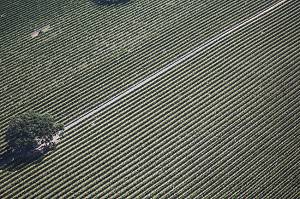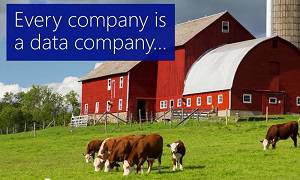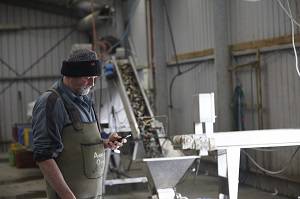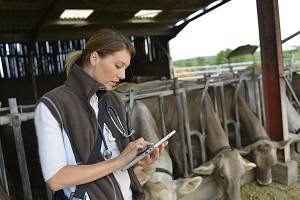Top digital trends re-shaping the future of agriculture

Introduction: State of the industry
Globally, one in nine people in the world today (795 million) are undernourished. More than three million children die unnecessarily from malnutrition every year. Food production will need to increase by at least 60% over the next 35 years to provide food security for the nine billion people expected to be living on the planet.1 These grim facts explain the urgency behind one of the United Nations’ 17 Sustainable Development Goals (SDGs), adopted by world leaders at its 2015 summit and put into effect in January 2016.
UN Sustainable Development Goal #2—end hunger, achieve food security and improved nutrition, and promote sustainable agriculture—is an immense undertaking. Climate change, instability in developing countries, degrading natural resources and unsustainable farming methods are all threatening progress. Achieving the 2030 Agenda for Sustainable Development requires multi-stakeholder partnerships to mobilize and contribute resources. Technology is once again serving as a change agent, enabling the global agriculture industry to rethink how it grows food, rethinking yield, water and energy efficiencies, etc.
The proof is in the numbers. Over the past five years, investment in agriculture technology, or the “agtech” sector, has accelerated from about $500 million in 2012 to $4.6 billion in 2015.2 Microsoft is helping to enable those investments with advanced technologies such as big data, cloud computing, the Internet of Things (IoT), analytics, drones, and more, delivering the promise of digital transformation. Through our end-to-end portfolio, highly scalable cloud infrastructure, and comprehensive partner network, including industry leaders such as Monsanto, we are uniquely positioned to invest in agtech and help the industry make a sustainable difference in tackling global hunger and food security.
Let us look at the trends shaping the industry today, and how Microsoft is working to enable customers, partners and communities to embrace this transformation.

Trend 1: Making smart farms a reality through precision farming
A prime example of digital transformation that aligns with UN SDG #2 is the growth of “precision farming.” A new generation of farmers is using advanced technology and remote sensing data to improve profits and harvest yields, while reducing the use of chemicals. By applying cloud, big data and mobile technologies to the planning, planting, growing and harvesting of crops, precision farmers are seeing a profound impact on increasing agricultural yields and on-farm productivity.
To understand precision farming, I ask you to picture a farm where sensors continuously measure soil parameters. Equipment detects exactly the right amount of fertilizer to spray on a given plant. And, aerial imagery analysis reveals how new crops are sprouting. The agtech revolution is making this vision a reality, enabling farmers to ensure that the right mix of water, nutrients and crop protection materials are being distributed to a given area.
A recent study by the International Food Policy Research Institute shows that by 2050, data-driven agricultural techniques can increase global crop yields by as much as 67% and reduce food prices by nearly half.3
We are already seeing what digital transformation can make possible in the industry. One of the largest distributors of agtech to farmers in the United States is Land O’Lakes, a member-owned agricultural cooperative. Using an Azure-based application to aggregate satellite data, weather data and agronomic research, Land O’ Lakes is helping their 4,000-member agriculture, dairy producers, and independently owned and operated ag retailers to optimize their production and output, while minimizing their inputs, all in the most sustainable way possible.
The Dow Chemical Company is also embracing advanced technology to make a difference in the industry. To create specialized agriculture products that maximize crop yields in local conditions, Dow needed real-time access to corporate data, as well as the ability to work closely onsite with customers. The company turned to the Microsoft Cloud, giving Dow team members access to specialized apps and data from anywhere—even farmers’ fields.

Another example of digital transformation involves Fujitsu and SCR Dairy. These companies are using IoT-enabled cow monitoring systems, and the power of machine learning and artificial intelligence, to help farmers increase their milk and beef production while ensuring healthier cows. What’s more, our partnership with Fujitsu is transforming lettuce production through the use of IoT, machine learning, analytics and mobile technologies. Fujitsu is now growing the perfect lettuce by ensuring greenhouse conditions are optimized, using an unprecedented level of automation to manage precision, consistency and predictability.
Trend 2: The potential of TV white spaces and sensors
While technology is instrumental in helping today’s farmer, its adoption is often limited. Farms usually do not have power, or Internet connectivity, and the farmers are typically not technology savvy. At the January 2017 G20 summit of agricultural ministers representing 20 major economies, the Food and Agriculture Organization Director-General José Graziano da Silva promoted a digital strategy that aims to support the world’s most vulnerable through knowledge sharing and bottom-up learning.4
The FAO says that “In an era in which challenges like climate change and natural resource scarcity are making agriculture ever more knowledge-intensive, family farmers in the developing world need information and technology tools that can help them not just get by, but thrive and feed a growing world population.”

And, we couldn’t agree more. Microsoft is supporting broader adoption of a digital strategy with research investments such as our FarmBeats program. We are working towards an end-to-end approach, using low-cost sensors, drones, and vision and machine learning algorithms—along with TV White Spaces networks—to help farmers gain the information and tools they need to feed a growing world population.
For the past year, our engineers have been developing these technologies at Dancing Crow farm in Seattle, Washington. By using sensors and clever algorithms to deliver water, fertilizers and pesticides to crops that need them, we’re striving to slash the cost of precision farming. The tremendous progress that our teams are making with sensors and drones could revolutionize how even the poorest farmers boost their output and save costs, all while avoiding excessive pesticide use.
Trend 3: Predicting the weather to take the guesswork out of farming
Changes in weather have a significant impact on industry success and outcomes, potentially costing growers hundreds of thousands of dollars every year. Big data and advanced analytics can be used to predict short-term weather, and the effect on a given farm, to ensure that the right quantity and mix of products are available when needed. The result is optimized crop yields and reduced environmental impact, which enables producers to feed more consumers and expend fewer resources.
 With the goal of helping farmers “feed the world without wrecking the planet,” an Australian-based IoT startup called The Yield is striving to change the face of agriculture and aquaculture. To overhaul reliance on rain gauges to measure the dangers of heavy rain washing contaminants into oyster bays, the Yield is leveraging Microsoft’s Azure IoT suite to power real-time sensors. These sensors sit in oyster leases and analyze the water that the oysters drink. With Azure’s cloud platform enabling machine learning and advanced analytics capabilities delivering data-based predictions to growers and regulators, the Yield is reducing unnecessary harvesting closures by 30 percent, saving about $5.3 million annually.
With the goal of helping farmers “feed the world without wrecking the planet,” an Australian-based IoT startup called The Yield is striving to change the face of agriculture and aquaculture. To overhaul reliance on rain gauges to measure the dangers of heavy rain washing contaminants into oyster bays, the Yield is leveraging Microsoft’s Azure IoT suite to power real-time sensors. These sensors sit in oyster leases and analyze the water that the oysters drink. With Azure’s cloud platform enabling machine learning and advanced analytics capabilities delivering data-based predictions to growers and regulators, the Yield is reducing unnecessary harvesting closures by 30 percent, saving about $5.3 million annually.
Next let’s travel to the U.S. for another case study involving oyster farmers using Microsoft Azure and cloud computing to predict ocean chemistry. A team from Microsoft Research and the University of Washington have developed a cloud-based predictive system. By providing forecasts about ocean water, the solution is help companies like Taylor Shellfish and the shellfish industry at-large survive changing conditions.
The next stop for our world tour highlighting Microsoft Azure in action is Andra Pradesh, a southeastern coastal state of India. Through Microsoft’s partnership with Icrisat (International Crops Research Institute for the Semi-Arid Topics) and the local government, data is being collected, analyzed and redistributed in easier-to-understand findings. Specifically, Microsoft and Icrisat are using artificial intelligence and Azure to help make agriculture more efficient through a sowing app. This easy to use tool advises on the best time to sow crops based on weather conditions, soil and other indicators.
 Trend 4: Increasing farm productivity through unexpected data partnerships
Trend 4: Increasing farm productivity through unexpected data partnerships
Managing resources optimally, and maximizing every acre of land, hinges on large amounts of data from a variety of sources. How the industry handles and exchanges big data is critical. It requires strong collaboration across an ecosystem of industry players, including farmers, agribusiness suppliers, equipment manufacturers, traders and technology providers—and even partners such as large animal veterinarians.
As farms get bigger and the number of livestock increases, farmers must pay greater attention to the farm’s overall productivity and what small changes will bring big improvements. For example, instead of calling a veterinarian to perform standard tasks like pregnancy scanning or hoof trimming, for example, farmers now look to vets for advice on animal health and welfare that will help improve farm efficiency and profitability. Farm vets are quickly realizing that they need to be able to better understand the performance of the farm, along with the health and productivity of the animals, before they make a farm visit. To do this, they need data.
Microsoft ISV FarmVet Systems created VetIMPRESS, a secure, web-based software-as-a-service solution developed with Visual Studio is designed to help vets have access to previously unavailable and unrecorded farm and animal data to create a comprehensive picture of animal health and productivity and better serve their clients.
Summary
The countdown to realizing the UN’s 2030 Sustainable Development Agenda has begun. The several examples that I shared demonstrate how the agricultural industry is pursuing the audacious goal of “ending hunger, achieving food security and improved nutrition, and promoting sustainable agriculture.” The future of agriculture lies in smart farming and digital transformation, with systems of intelligence including cloud computing, big data platforms, IoT, predictive analytics and other new capabilities. Microsoft is proud to deliver technologies that accelerate the UN’s goals by enabling agricultural firms to become thriving digital businesses, providing sustainable food and nutrition to the world.
To get started on your digital transformation journey, download our new whitepaper.
Twitter: @Caglayan_Arkan
Sources:
1-United Nations, Sustainable Development Goals, Hunger and Food Security, January 2016.
2– AgFunder Releases Mid-Year 2016 Agriculture Technology Investment Report, AgFunder, August 9, 2016.
3-H. C. J. Godfray, J. R. Beddington, I. R. Crute, L. Haddad, D. Lawrence, J. F. Muir, J. Pretty, S. Robinson, S. M. Thomas, and C. Toulmin. Food security: The challenge of feeding 9 billion people, Science, February 12, 2010.
4– More support to family farmers needed to meet world’s rising food demands, FAO tells G20, EIN News, January 22, 2017.




